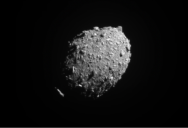NASA May Have Accidentally Nudged An Asteroid Toward Mars

Human beings have been preoccupied for some time with the idea of an asteroid hitting Earth and ending things in one quick explosion.
After learning what happened to the dinosaurs, maybe it’s understandable.
That said, I don’t think NASA intended to nudge one toward Mars.
It happened in 2022, when NASA sent a spaceship up to bump into an asteroid called Dimorphos in an attempt to alter its course.
The mission was successful, which was (of course) great news.
Unfortunately, large boulders ranging in size from 3-22 feet broke off of the main asteroid and floated off on their own.
When charting where these 37 pieces will venture in the next 20,000 years, they discovered that although Earth is safe from any impact, Mars might not be so lucky.
“Numerical simulations show that all the boulders of the swarm will cross the orbit of Mars multiple times in the future 20 thousand years. The simulated swarm is statistically representative of the set of 37 actual boulders recently discovered by using observations from the Hubble Space Telescope that were ejected during the impact of the DART spacecraft on Dimorphos. Therefore, due to the orbit crossings happening in the long-term evolution, it is possible that some of the boulders will impact Mars in the future.”
These potential impacts happen twice around 6,000 years in the future, then again 9,000 years later.
That said, there are variables that could alter the rock’s path between now and then.
“The condition of fragmentation, assuming a mean strength of about 1 MPa, is reached when the meteoroid hits the Martian soil without generating airbursts and with a speed slightly lower than the initial one because the Martian atmosphere is too thin to slow it down significantly. For this reason, in our case, a small, simple impact crater of about 200-300 m in diameter will be generated.”
If the boulders are weaker than predicted, though, they could break up in the Martian atmosphere without ever reaching the surface in one piece.
It’s amazing how much we can know, and how much remains out of our hands.
Hopefully no one living on Mars in 6,000 years has to bear the brunt of this decision, though.
If you thought that was interesting, you might like to read a story that reveals Earth’s priciest precious metal isn’t gold or platinum and costs over $10,000 an ounce!

Sign up to get our BEST stories of the week straight to your inbox.




